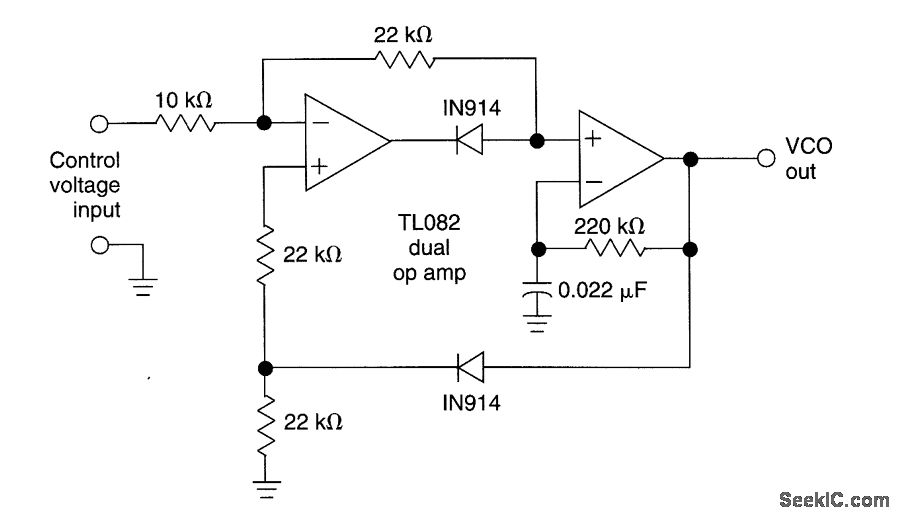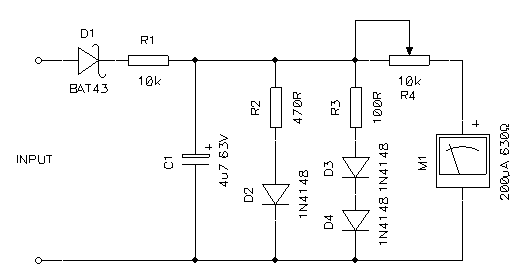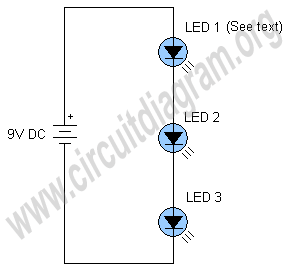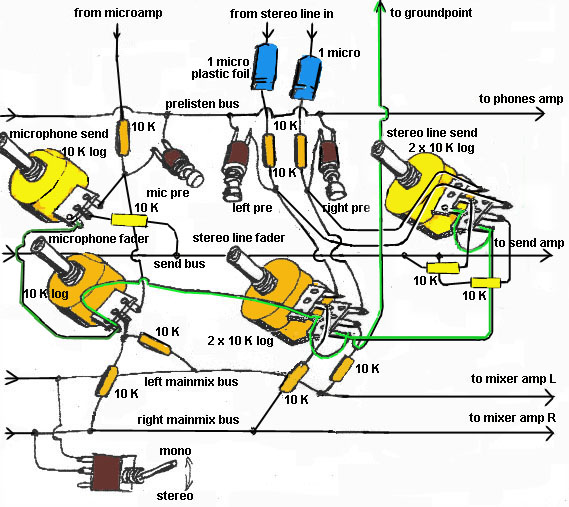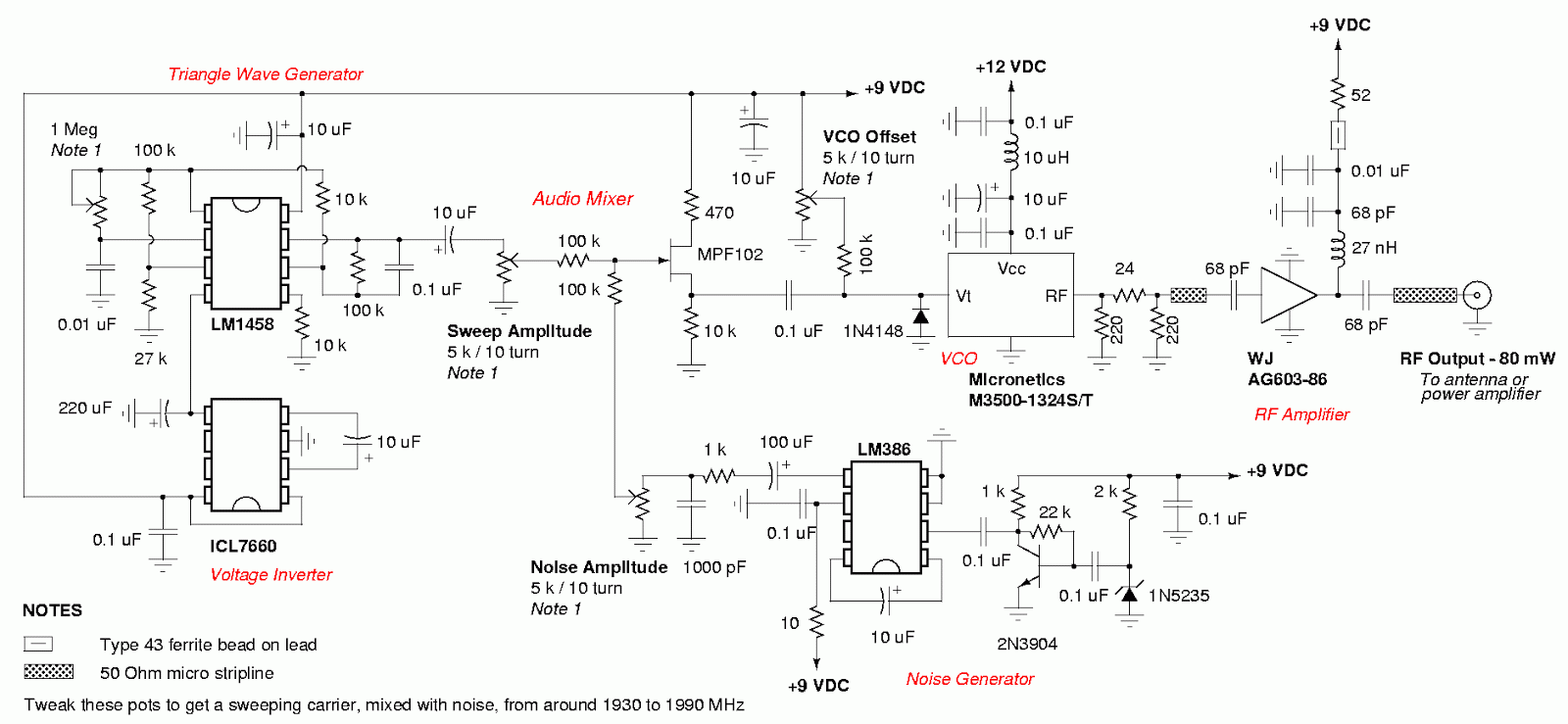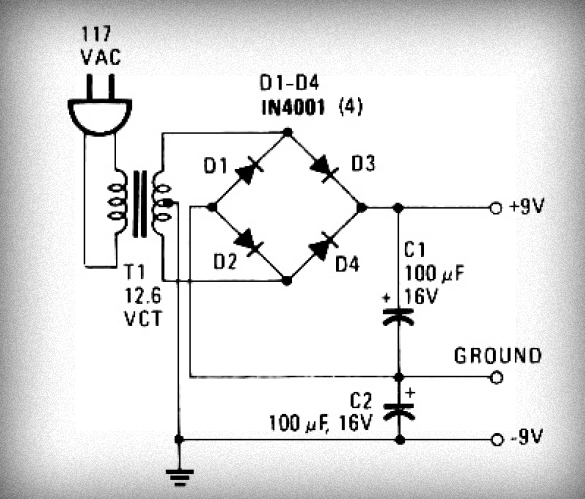
Simple UPS
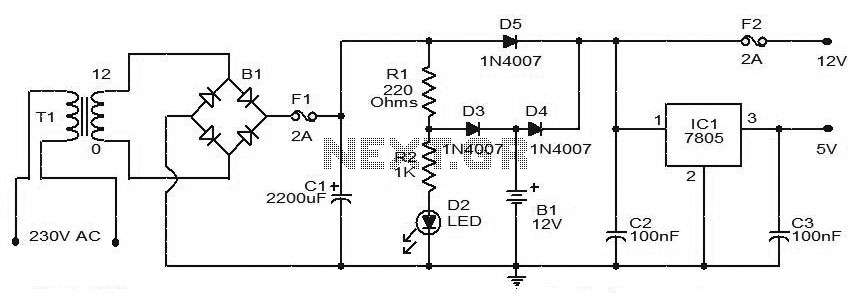
This circuit diagram represents a simple Uninterruptible Power Supply (UPS) capable of delivering 12V unregulated and 5V regulated DC output. The transformer T1 reduces the mains voltage to 12V AC, which is then rectified by bridge B1. The rectified output is smoothed using capacitor C1. When mains power is available, the battery charges through diode D3, while the regulator integrated circuit (IC) receives supply via diode D5, providing 12V and 5V DC at the output terminals. In the absence of mains power, the battery supplies current to the regulator IC and to the 12V DC terminal through diode D4. Diode D3 prevents reverse current flow during battery operation. Capacitors C2 and C3 function as filters. The inquiry also includes questions regarding the inverter's operation to convert 12V to 220V, the internal battery bank circuitry, and methods to assess the health of the UPS and its batteries. Additionally, a request for a circuit design featuring a 16V unregulated and 12V regulated output with a minimum of 1.2A is made, alongside questions about modifying the circuit by using a 7812 IC instead of a 7805 IC and removing a resistor for improved battery charging efficiency.
The UPS circuit operates by converting AC mains voltage to a lower DC voltage suitable for charging batteries and powering devices. The transformer T1 plays a critical role in this process, stepping down the mains voltage to 12V AC. The bridge rectifier B1 then converts this AC voltage to pulsating DC. The smoothing capacitor C1 is essential for reducing the ripple voltage, ensuring a more stable DC output.
When the mains supply is active, the system allows for battery charging via diode D3, which prevents backflow of current. The output voltage regulation is achieved through the use of a linear voltage regulator IC, which in this case can be a 7805 for 5V output or a 7812 for 12V output, depending on design requirements. The presence of diodes D4 and D5 ensures that the system can seamlessly switch between mains supply and battery operation without damaging components.
The inquiry about the inverter's function in stepping up the voltage from 12V to 220V indicates an interest in understanding the additional components required for this conversion. Typically, an inverter circuit would include an oscillator to generate a high-frequency AC signal, followed by a transformer designed to step up the voltage to the desired level. The absence of these components in the provided schematic suggests that the UPS design may be focused solely on DC outputs without an integrated inverter section.
Regarding battery health assessment, it is advisable to monitor individual battery voltages and internal resistances to evaluate their condition. This can be accomplished using a battery management system (BMS) that provides data on each cell's performance, allowing for more accurate health assessments.
The request for a circuit capable of delivering 16V unregulated and 12V regulated output at 1.2A necessitates careful consideration of component ratings. The choice of a 16-0 3A step-down transformer is appropriate, as it provides sufficient current capacity for the application. The use of a 7812 voltage regulator instead of a 7805 will effectively yield the desired 12V output, provided that the input voltage remains within the acceptable range for the regulator.
The discussion about removing the 220-ohm resistor (R1) for improved battery charging efficiency raises important considerations. While it may seem beneficial to eliminate this resistor to increase current flow, it is essential to evaluate the impact on the charging circuit's functionality. Removing R1 could potentially lead to excessive charging currents, which may damage the battery or reduce its lifespan. It is critical to ensure that the charging circuit maintains appropriate current levels to prevent overcharging while still providing efficient operation.
In conclusion, the circuit design and modifications should be approached with caution, ensuring that all components are appropriately rated and that the system operates within safe parameters to maintain reliability and performance.This is the circuit diagram of a simple UPS that can deliver 12V unregulated and 5V regulated DC. The transformer T1 steps down the mains voltage to 12V AC and then the bridge B1 rectifies it. The rectified signal is smoothed by the capacitor C1. When the mains supply is available the battery will be charged via diode D3 and the regulator IC gets s upply via diode D5. 12V and 5V DC will be available at the output terminals. When mains supply is not available the battery supplies current to the regulator IC and to the 12V DC terminal through diode D4. Also, the diode D3 blocks reverse flow of current during battery mode. Capacitors C2 and C3 acts as filters. i want to know how the inverter change the 12v to the 220v cos i can not see the step up transformer in the circuit and more so the inverter circuit is not clear to me.
sir i want to see the battery bank circuitry inside the ups and how we can estimate the ups health and this is possible to estimate batteries health individually or we can estimate the health of the banks as a whole. thanks for quick reply. I need a circuit of 16v unregulated and 12v regulated with atleast 1. 2A as output. I`m planning to use 16-0 3A step down transformer. So i`m planning to use 7812 IC instead of 7805 ic inside the circuit to get 12v 1. 2A as the output. My questions are 4)Also i want to add a battery over charging protector circuit as in. its for 6v battery. i want to use it for my 12v battery with 16v transformer o/p. just tell me what all to be changed. Plz kindly answer all the 4 questions. Plz sir, i`m in very confused situation. I know i`m torturing you, even though i`m thanking you for your valuable support. Thanks will u plz reply via email ganeshrnet{@}live{. }com thanks for quick reply. I need a circuit of 16v unregulated and 12v regulated with atleast 1. 2A as output. I`m planning to use 16-0 3A step down transformer. So i`m planning to use 7812 IC instead of 7805 ic inside the circuit to get 12v 1. 2A as the output. My questions are Sir, i wish to know whether the removal of R1 which is 220ohms for better charging of the 12v battery I think the battery when connected in serial with a resistor will reduce the charging efficiency So if we can remove and adjust the resistor, it will be better no Is there any problem in that Will it affect auto charging or will it reduce the output voltage to the unregulated 12v lead, while in power mode condition And also I`ve designed my own circuit diagram removing R1 220ohm.
the link to the described diagram is : please see it and reply via email ganeshrnet{@}live[. ]com 🔗 External reference
The UPS circuit operates by converting AC mains voltage to a lower DC voltage suitable for charging batteries and powering devices. The transformer T1 plays a critical role in this process, stepping down the mains voltage to 12V AC. The bridge rectifier B1 then converts this AC voltage to pulsating DC. The smoothing capacitor C1 is essential for reducing the ripple voltage, ensuring a more stable DC output.
When the mains supply is active, the system allows for battery charging via diode D3, which prevents backflow of current. The output voltage regulation is achieved through the use of a linear voltage regulator IC, which in this case can be a 7805 for 5V output or a 7812 for 12V output, depending on design requirements. The presence of diodes D4 and D5 ensures that the system can seamlessly switch between mains supply and battery operation without damaging components.
The inquiry about the inverter's function in stepping up the voltage from 12V to 220V indicates an interest in understanding the additional components required for this conversion. Typically, an inverter circuit would include an oscillator to generate a high-frequency AC signal, followed by a transformer designed to step up the voltage to the desired level. The absence of these components in the provided schematic suggests that the UPS design may be focused solely on DC outputs without an integrated inverter section.
Regarding battery health assessment, it is advisable to monitor individual battery voltages and internal resistances to evaluate their condition. This can be accomplished using a battery management system (BMS) that provides data on each cell's performance, allowing for more accurate health assessments.
The request for a circuit capable of delivering 16V unregulated and 12V regulated output at 1.2A necessitates careful consideration of component ratings. The choice of a 16-0 3A step-down transformer is appropriate, as it provides sufficient current capacity for the application. The use of a 7812 voltage regulator instead of a 7805 will effectively yield the desired 12V output, provided that the input voltage remains within the acceptable range for the regulator.
The discussion about removing the 220-ohm resistor (R1) for improved battery charging efficiency raises important considerations. While it may seem beneficial to eliminate this resistor to increase current flow, it is essential to evaluate the impact on the charging circuit's functionality. Removing R1 could potentially lead to excessive charging currents, which may damage the battery or reduce its lifespan. It is critical to ensure that the charging circuit maintains appropriate current levels to prevent overcharging while still providing efficient operation.
In conclusion, the circuit design and modifications should be approached with caution, ensuring that all components are appropriately rated and that the system operates within safe parameters to maintain reliability and performance.This is the circuit diagram of a simple UPS that can deliver 12V unregulated and 5V regulated DC. The transformer T1 steps down the mains voltage to 12V AC and then the bridge B1 rectifies it. The rectified signal is smoothed by the capacitor C1. When the mains supply is available the battery will be charged via diode D3 and the regulator IC gets s upply via diode D5. 12V and 5V DC will be available at the output terminals. When mains supply is not available the battery supplies current to the regulator IC and to the 12V DC terminal through diode D4. Also, the diode D3 blocks reverse flow of current during battery mode. Capacitors C2 and C3 acts as filters. i want to know how the inverter change the 12v to the 220v cos i can not see the step up transformer in the circuit and more so the inverter circuit is not clear to me.
sir i want to see the battery bank circuitry inside the ups and how we can estimate the ups health and this is possible to estimate batteries health individually or we can estimate the health of the banks as a whole. thanks for quick reply. I need a circuit of 16v unregulated and 12v regulated with atleast 1. 2A as output. I`m planning to use 16-0 3A step down transformer. So i`m planning to use 7812 IC instead of 7805 ic inside the circuit to get 12v 1. 2A as the output. My questions are 4)Also i want to add a battery over charging protector circuit as in. its for 6v battery. i want to use it for my 12v battery with 16v transformer o/p. just tell me what all to be changed. Plz kindly answer all the 4 questions. Plz sir, i`m in very confused situation. I know i`m torturing you, even though i`m thanking you for your valuable support. Thanks will u plz reply via email ganeshrnet{@}live{. }com thanks for quick reply. I need a circuit of 16v unregulated and 12v regulated with atleast 1. 2A as output. I`m planning to use 16-0 3A step down transformer. So i`m planning to use 7812 IC instead of 7805 ic inside the circuit to get 12v 1. 2A as the output. My questions are Sir, i wish to know whether the removal of R1 which is 220ohms for better charging of the 12v battery I think the battery when connected in serial with a resistor will reduce the charging efficiency So if we can remove and adjust the resistor, it will be better no Is there any problem in that Will it affect auto charging or will it reduce the output voltage to the unregulated 12v lead, while in power mode condition And also I`ve designed my own circuit diagram removing R1 220ohm.
the link to the described diagram is : please see it and reply via email ganeshrnet{@}live[. ]com 🔗 External reference
Warning: include(partials/cookie-banner.php): Failed to open stream: Permission denied in /var/www/html/nextgr/view-circuit.php on line 713
Warning: include(): Failed opening 'partials/cookie-banner.php' for inclusion (include_path='.:/usr/share/php') in /var/www/html/nextgr/view-circuit.php on line 713
